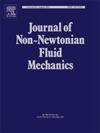Recovery dynamics and polymer scission in capillary breakup extensional rheometry
IF 2.7
2区 工程技术
Q2 MECHANICS
引用次数: 0
Abstract
Capillary breakup extensional rheometry (CaBER) is a technique widely used to quantitatively measure the transient extensional rheology of a visco-elastic fluid. In this paper, we investigate some of the shortcomings of measuring the transient relaxation time through CaBER and Dripping onto Substrate (DoS)-CaBER experimentation and describe problematic conditions for which consistency of results is not achieved. Using a high molecular weight polyacrylamide polymer in a viscous water and glycerol solution, we investigated the effect that the choice of syringe size, tubing size, tubing length and flow rate used to generate the liquid bridge in DoS-CaBER can have on the decay evolution of the fluid filament. The resulting measurements showed a sharp decrease in extensional viscosity and relaxation time with increasing strength of the shear and extensional flows within the syringe and tubing used to generate the pendant drop. These measurements highlighted the importance of considering the flow and deformation history of the polymer prior to the DoS-CaBER and CaBER stretches. In order to understand whether these observed effects were due to recoverable pre-deformation of the polymer or permanent scission of the polymer, the DoS-CaBER syringe setup was used to deposit the polymer solution into a CaBER under different loading conditions. CaBER tests were then performed with various delay times to erase the deformation history of loading. For these samples, rest times of more than 100 extensional relaxation times were required to erase the deformation history caused by the loading of the sample. Even with the pre-conditioning erased, however, unrecoverable losses in relaxation time and extensional viscosity remained. These observations indicate that polymer scission occurred in all samples where loading resulted in an extensional Weissenberg number greater than . Next, the effect of successive CaBER stretches on a single sample and the time delay imposed between successive stretches on the fluid rheology was studied. Stretches performed immediately one after the other with no recovery time built in showed a steep decline in measured relaxation time and breakup time. However, even with post stretch delays of twenty minutes, full recovery of the initial fluid properties was not achieved suggesting that extensional flow induced scission of the polymer had occurred even in CaBER. Thus, it is clear that the effect of preconditioning a viscoelastic fluid is strong, and these factors need to be considered prior to conducting CaBER and DoS-CaBER experiments in the future.
毛细管破裂中聚合物断裂的恢复动力学和拉伸流变学
毛细管破裂拉伸流变学(CaBER)是一种广泛用于定量测量粘弹性流体瞬态拉伸流变学的技术。在本文中,我们研究了通过CaBER和滴到衬底(DoS)-CaBER实验测量瞬态弛豫时间的一些缺点,并描述了结果不一致的问题条件。采用高分子量的聚丙烯酰胺聚合物(MW=18x106g/mol),在黏性水和甘油溶液中,研究了DoS-CaBER中用于产生液桥的注射器尺寸、管道尺寸、管道长度和流速的选择对液桥衰变演化的影响。结果表明,随着用于产生垂坠滴的注射器和油管内剪切和拉伸流强度的增加,拉伸粘度和松弛时间急剧下降。这些测量强调了在DoS-CaBER和CaBER拉伸之前考虑聚合物流动和变形历史的重要性。为了了解这些观察到的影响是由于聚合物的可恢复预变形还是聚合物的永久断裂,使用DoS-CaBER注射器装置在不同的加载条件下将聚合物溶液沉积到CaBER中。然后进行了不同延迟时间的CaBER试验,以消除加载的变形历史。对于这些样品,需要超过100次的拉伸松弛时间来消除由样品加载引起的变形历史。然而,即使消除了预处理,松弛时间和拉伸粘度的不可恢复损失仍然存在。这些观察结果表明,在加载导致拉伸Weissenberg数大于Wi>;8s−1的所有样品中都发生了聚合物断裂。其次,研究了连续CaBER拉伸对单个样品的影响以及连续拉伸之间施加的时间延迟对流体流变学的影响。在没有设定恢复时间的情况下,一个接一个立即进行拉伸,结果显示,测量到的放松时间和分解时间急剧下降。然而,即使拉伸后延迟20分钟,也不能完全恢复初始流体性质,这表明即使在CaBER中也发生了拉伸流动引起的聚合物断裂。因此,很明显,预处理粘弹性流体的效果是很强的,在未来进行CaBER和DoS-CaBER实验之前,需要考虑这些因素。
本文章由计算机程序翻译,如有差异,请以英文原文为准。
求助全文
约1分钟内获得全文
求助全文
来源期刊
CiteScore
5.00
自引率
19.40%
发文量
109
审稿时长
61 days
期刊介绍:
The Journal of Non-Newtonian Fluid Mechanics publishes research on flowing soft matter systems. Submissions in all areas of flowing complex fluids are welcomed, including polymer melts and solutions, suspensions, colloids, surfactant solutions, biological fluids, gels, liquid crystals and granular materials. Flow problems relevant to microfluidics, lab-on-a-chip, nanofluidics, biological flows, geophysical flows, industrial processes and other applications are of interest.
Subjects considered suitable for the journal include the following (not necessarily in order of importance):
Theoretical, computational and experimental studies of naturally or technologically relevant flow problems where the non-Newtonian nature of the fluid is important in determining the character of the flow. We seek in particular studies that lend mechanistic insight into flow behavior in complex fluids or highlight flow phenomena unique to complex fluids. Examples include
Instabilities, unsteady and turbulent or chaotic flow characteristics in non-Newtonian fluids,
Multiphase flows involving complex fluids,
Problems involving transport phenomena such as heat and mass transfer and mixing, to the extent that the non-Newtonian flow behavior is central to the transport phenomena,
Novel flow situations that suggest the need for further theoretical study,
Practical situations of flow that are in need of systematic theoretical and experimental research. Such issues and developments commonly arise, for example, in the polymer processing, petroleum, pharmaceutical, biomedical and consumer product industries.

 求助内容:
求助内容: 应助结果提醒方式:
应助结果提醒方式:


